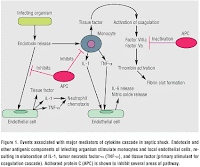Septic shock
Journal of Anesthesia and Anesthetic Drugs ISSN: 2770-9108
J Anaesth Anesth Drugs, 2022, 2(2): doi https://doi.org/10.54289/JAAD00107
https://www.researchgate.net/publication/382428764_ebookpdf
Editorial article
Maria Dalamagka
Patients who present to the emergency department demonstrating clinical signs of circulatory shock constitute a medical emergency, often associated with significant mortality. Severe sepsis, characterized as infection with systemic manifestations and accompanying organ dysfunction or tissue hypoperfusion, can lead to septic shock.Septic shock is defined as severe sepsis plus sepsis-induced hypotension not reversed with adequate fluid resuscitation. Hypotension may be defined by a drop in systolic blood pressure (SBP) to < 90 mm Hg or by at least a 40-mm Hg from baseline. The inadequate perfusion of critical organs (heart, liver, and kidneys) may lead to significant morbidity and mortality.Initial hemodynamic management of patients presenting with hypotension and concern for septic shock should consist of fluid therapy with 10-40 cc/kg of crystalloids, preferably normal saline, or lactated Ringer's solution. Various medications are used in the treatment of patients in circulatory shock.The use of vasopressors is an important component of resuscitation efforts, with the goal of therapy to maintain mean arterial pressure (MAP) at least 65 mm Hg. Dopamine and norepinephrine have generally been considered first-line agents in patients presenting with septic shock; in fact, recent consensus guidelines and expert recommendations have suggested that either agent may be used as a first-choice vasopressor in patients who have septic shock. Epinephrine, vasopressin, and neosynephrine may be useful second-line agents. Inotropic therapy with dobutamine may also be necessary in myocardial dysfunction.Because hypotension may be life-threatening, vasopressors help to maintain adequate blood flow and tissue perfusion despite hypovolemia. Dopamine increases heart rate and stroke volume, leading to an increase in cardiac output and MAP. In contrast, norepinephrine is a vasoconstrictor and thereby increases MAP with little effect on heart rate and stroke volume. While norepinephrine is considered to be more potent and thereby more effective in increasing blood pressure in septic shock, dopamine may be useful in patients with systolic dysfunction, but is also associated with more tachycardia and dysrhythmias. There is also concern regarding adverse effects on the endocrine and immune systems with dopamine. It has also been noted that norepinephrine may potentially decrease cardiac output, oxygen delivery, and blood flow to vulnerable organs despite adequate perfusion pressure.. Meanwhile, vasopressin, an endogenously released peptide hormone, has emerged as an adjunct to catecholamines for patients who have severe septic shock. The rationale for its use is the relative vasopressin deficiency in patients in septic shock and the hypothesis that exogenously administered vasopressin can restore vascular tone and blood pressure, thereby reducing the need for the use of catecholamines. Observational studies involving the use of vasopressin infusion rates below 0.1 units per minute in patients in vasodilatory shock have repeatedly shown improved short-term blood pressure responses.However, vasopressin infusion may also decrease blood flow in the heart, kidneys, and intestine.Interestingly, despite the widespread use of vasopressin in clinical practice, only 2 small randomized trials have evaluated its use in patients in septic shock. Vasopressin increased blood pressure, decreased catecholamine requirements, and improved renal function as compared with a control medication. However, the trials were only powered to evaluate mortality, organ dysfunction, or safety.




Comments
Post a Comment